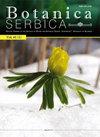葫芦巴种子的植物化学筛选及抗氧化活性研究
IF 1.1
4区 生物学
Q4 PLANT SCIENCES
引用次数: 0
摘要
Trigonella属(豆科)自古以来就被广泛用于烹饪和临床目的。本文首次对葫芦巴种子的化学成分及体外抗氧化活性进行了研究。这些种子是在土耳其梅尔辛省收集的。采用色谱法进行化学分析。对己烷提取物进行脂肪酸、生育酚和甾醇分析,对种子进行氨基酸和矿物质分析。采用Folin-Ciocalteu法和Al(NO3)3法测定其总酚和类黄酮含量,并采用1,1-二苯基-2-吡啶肼(DPPH)、铜还原抗氧化能力(CUPRAC)和2,2 - 3-乙基苯并噻唑啉-6-磺酸盐(ABTS?+)等不同的化学测定方法对其80%甲醇提取物进行体外抗氧化活性评价。结果表明,该种子主要含有亚油酸、-亚麻酸和油酸(分别为43.74 - 0.24%、18.38 - 0.45%和10.89 - 0.71%)。种子中-生育酚含量较高(233.54 ~ 2.48 mg/100 g),主要甾醇为-谷甾醇、-5-阿芬那甾醇和油菜甾醇。Na、K、Ca、P和Mg为主要矿物质,谷氨酸、天冬氨酸和赖氨酸为主要氨基酸(分别为5801 - 0.15、3629 - 0.12和2062 - 0.03 Mg /100 g)。总酚和总黄酮含量分别为3.34±0.02 mg GAE/g和0.96±0.09 mg QE/g。ABTS的结果是什么?+, DPPH ?CUPRAC法分别为43.22 - 3.14%、31.15 - 1.79%和9.67 - 0.78 mM AAE/g。综上所述,山核桃种子具有丰富的营养价值,富含多不饱和脂肪酸、-生育酚、-谷甾醇、部分氨基酸和矿物质,具有一定的药用价值,具有一定的总酚和类黄酮含量,并具有抗氧化活性。本文章由计算机程序翻译,如有差异,请以英文原文为准。
Phytochemical screening and antioxidant activity of Trigonella cariensis seeds
The genus Trigonella (Fabaceae) has been widely used for both culinary and clinical purposes since ancient times. The aim of this study was to investigate the chemical composition and in vitro antioxidant activities of Trigonella cariensis seeds for the first time. The seeds were collected in the province of Mersin, Turkey. Chemical analyses were performed using chromatographic methods. Fatty acid, tocopherol and sterol analyses were done on hexane extracts and amino acid and mineral analyses were also carried out on the seeds. The total phenolic and flavonoid contents were measured by using the Folin-Ciocalteu and Al(NO3)3 methods and in vitro antioxidant activity was evaluated via different chemical assays including 1,1-diphenyl-2-picrylhydrazily (DPPH?), cupric reducing antioxidant power (CUPRAC) and 2,2?-azinobis(3-ethylbenzothiazoline)-6-sulphonate (ABTS?+) on its 80% methanolic extract. The seeds were shown to contain mainly linoleic, ?-linolenic and oleic acids (43.74?0.24%, 18.38?0.45%, and 10.89?0.71%, respectively). The seeds showed high ?-tocopherol content (233.54?2.48 mg/100 g). The main sterols were ?-sitosterol, delta-5-avenasterol and campesterol. Na, K, Ca, P, and Mg were the predominant minerals, while glutamic acid, aspartic acid and lysine (5801?0.15, 3629?0.12 and 2062?0.03 mg/100 g, respectively) were determined as the major amino acids in the seeds. The total phenolic and flavonoid contents were 3.34?0.02 mg GAE/g seed and 0.96?0.09 mg QE/g seed, respectively. The results of the ABTS?+, DPPH? and CUPRAC methods were 43.22?3.14%, 31.15?1.79% and 9.67?0.78 mM AAE/g, respectively. In conclusion, T. cariensis seeds provide nutritional value with a good source of polyunsaturated fatty acids, ?-tocopherol, ?-sitosterol, some amino acids and minerals and medicinal properties with total phenolic and flavonoid contents and antioxidant activities.
求助全文
通过发布文献求助,成功后即可免费获取论文全文。
去求助
来源期刊

Botanica Serbica
Agricultural and Biological Sciences-Plant Science
CiteScore
1.40
自引率
12.50%
发文量
17
审稿时长
34 weeks
期刊介绍:
Botanica Serbica publishes original research papers on all aspects of plant, fungal and microbial biology research including the disciplines of microbiology, mycology, lichenology, bryology, flora, vegetation, biogeography, systematics, taxonomy, plant biotechnology, plant cell biology, plant ecology, environmental plant biology, forestry, genomics, horticulture, limnology, metabolomics, molecular biology, proteomics, virology, plant conservation and protection, and wildlife and ecosystem management.
 求助内容:
求助内容: 应助结果提醒方式:
应助结果提醒方式:


